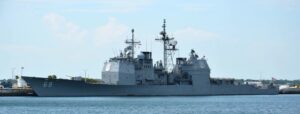The Navy’s top officer said up to half of surface ship maintenance delay days are tied to several vessels the service wants to decommission.
“We’ve gone from 7,700 delay days out of shipyards…down to a little over 3,000 today. We are nowhere near where we need to be. I will say that between 40 and 50 percent of those delay days I can attribute to six or seven ships that we’d like to decommission because they are old, and they’re not fit to fight against the current threat,” Adm. Mike Gilday, Chief of Naval Operations, said during a virtual event hosted by the Atlantic Council on Wednesday.
He said the ships were designed in the 1970s “for a fight of a bygone age, but we’re still holding on to them, in any case, so they attribute for a high percentage of those delay days.”

In August, the Navy released its list of ships it intends to decommission in fiscal year 2023, unless Congress prevents any. It includes two Los Angeles-class submarines, five Ticonderoga-class cruisers (CGs), nine Freedom-variant Littoral Combat Ships (LCSs), four Whidbey Island-class dock landing ships (LSDs), and several other Military Sealift Command roll on/roll off cargo ships, replenishment oilers, Expeditionary Transfer Dock ships (ESDs), and Cyclone-class patrol ships (Defense Daily, Aug. 17).
Gilday said the Navy decides on these decommissionings by ranking platform by lethality, across platforms, ranked from one to 20. “That helps inform the decision on what we’re going to put on the table to decom…it gets back to what we can afford.”
The CNO argued while he regrets some of the ships on the decommissioning table, “there are others that haven’t seen a drydock since 2009. There are some that have 125 departure[s] from specifications [on one ship]”
He underscored one example where one ship had an engineering directive to not put a tug against a side of the ship because the steel is too thin and they are worried about making a hole in the hull.
Gilday also said some of the cruisers on the list are “three years behind in coming out of maintenance at costs of $80 million or more, with a weapons system that is not going to be upgraded in time to face the threat that the Chinese pose.”
“So when it comes down to making hard decisions on where to put your next dollar, those are decisions that need to be made and debated within the Pentagon,” he added.
He said maintenance progress among the shipyards varies and they are in competition to drive down delay days.
“Yes, we’ve seen workforce issues, everybody has across all industries in the United States. And yes, we have supply chain issues. But those can’t be excuses.”
Gilday reiterated the service is trying to push from contracting a maintenance period with a private yard only 30 days before the start of maintenance to a goal of 120 days before work starts.
“I would like it to be 365 days where we could get those contracts way out to the left, identify those parts that we need, get them purchased. And the Congress has given us the ability to use funding across fiscal years to do this, so they’re with us. We have to prove ourselves that we’re going to deliver on this with respect to those authorities that they’re given us. But I think we’re making progress. But we got a ways to go.”
Gilday said the service has to focus on spending limited funds in a way that works to best counter China.
“When we make decisions on which ships we’re going to decommission, the entering argument is the size of the fleet that we can afford. An affordable fleet has everything to do with…readiness aspects.”
He said even with a general 8.3 percent inflation rate, 60 percent of the Navy’s budget rises above inflation.
“And so we have to take that into account, that maintaining the fleet that we have is extremely expensive.”